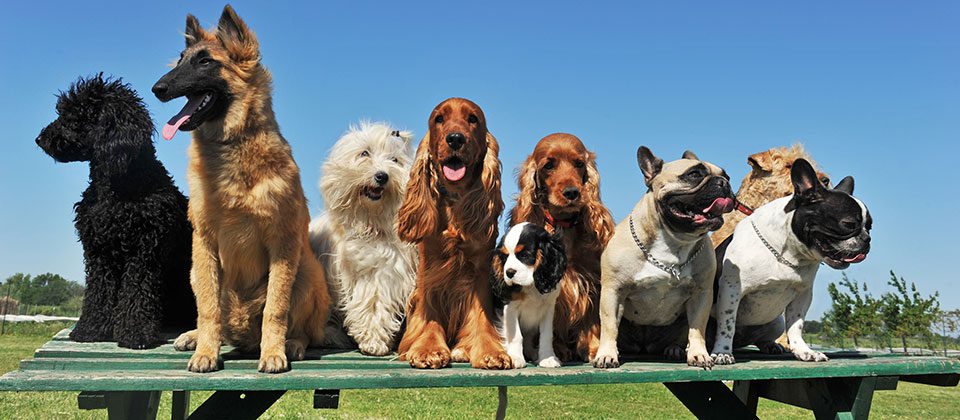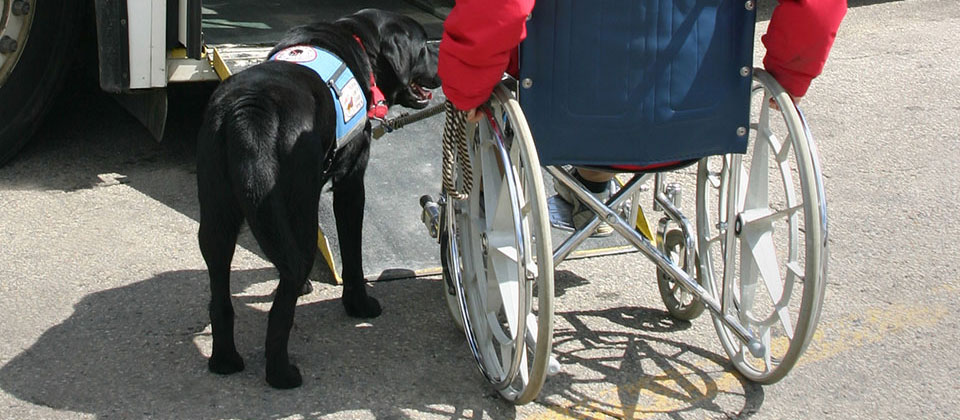As stated under the definition of a Service Dog, program-trained dogs, (dogs that have already undergone obedience training and have exhibited the characteristics required for a Service Dog) are matched with their future handler/recipient near the end of the training process. By this point, it is nearly certain the candidate dog will complete training and will become a service dog.
JUMP TO:
PUPPY TRAINING • PROGRAM TRAINED DOGS vs. OWNER TRAINED DOGS
OWNER TRAINED DOGS • PROGRAM TRAINED DOGS • ADVANCED TRAINING
PUPPY TRAINING
Service dog puppies are often fostered by their programs to private families to be reared until they are old enough for advanced training. During this time, the puppies are socialized through extensive interactions with people of all kinds (with variations in age, gender, ethnicity, mode of dress, disability, etc.) as well as with other common domestic animals, especially other dogs. Puppies are also habituated by their foster families so that they become comfortable in a wide variety of situations. The foster families, called puppy raisers or puppy walkers, take responsibility for teaching the pup basic life skills common to any well-behaved dog including basic obedience and manners. As examples, puppies in training to be service dogs typically have careful toilet training because they can go so many places that other animals cannot; behaviors that make the dogs easy to be around are also taught, such as not begging or jumping up on people, waiting at doors, riding in cars, coming when called, sitting, lying down, staying in different positions, and walking politely on a leash.
In recent years, many organizations have involved inmates in prisons for some initial puppy training. There are pros and cons to this move. For example, without the responsibilities of making a living, paying bills, driving the kids, etc., inmates typically have more time to spend with the puppy. There is a lot of walking in prison, and inmate-raised puppies thus have more opportunities to walk on a loose leash. In contrast, the early socialization that is a must for puppies is limited in a prison: all men, or all women, all dressed the same, few if any children, and a lack of new and various scents. Cars, bicycles, skateboards, backpacks, cats, and many other distractions are rare to non-existent in prisons. Still, these programs have been a success on many fronts with the help of professionals, and some forethought on program implementation.
Also, there is owner training, in which the disabled person does the training, from start to finish, without the help of a program. Not all SDs are program dogs.
PROGRAM-TRAINED DOGS VS. OWNER-TRAINED DOGS
A growing number of people choose to train their own service dogs. This can be because existing programs do not answer their needs (for example, a dog that can help someone in a wheelchair who is also hard of hearing). It can also be because the disabled person wants to experience the dog's puppyhood, or because he or she already has a pet dog when the need for a service dog arises, as well as owner training being significantly less expensive than professional training. This is permitted in some countries, such as the U.S., but not in all. Handlers with experience training advanced dogs may choose to train the dogs themselves, while others may employ a professional trainer or organization that accepts an owner's existing dog.
Program-trained dogs are matched with their future handler near the end of the training process. By this point, it is nearly certain the candidate dog will complete training and will become a service dog. Owner-trainers often start working with their puppies while they are very young, too young to be thoroughly evaluated. Owner-trainers whose puppies fail to measure up must deal with the emotional conflict of whether to re-home the dog or keep him as a pet.
Because most programs now breed their own puppies and raise them according to very carefully researched and planned guidelines, their success rates are relatively high. Owner-trainers, lacking the experience of the program trainers and not being able to manipulate the genetics or early neurological stimulation of the puppies, generally experience a lower success rate.
However, for a person with the skill to train their own service dog, this option can make dogs of specific breeds available that would not be available through a program, and allows for greater customization of training. For a handler used to a certain set of command words or who needs a cross-disability dog, this can be a very useful option.
OWNER TRAINED DOGS
Owner-trainers often start working with their puppies while they are very young, too young to be thoroughly evaluated. Owner-trainers whose puppies fail to measure up must deal with the emotional conflict of whether to re-home the dog or keep him as a pet.
Owner-trainers, lacking the experience of the program trainers and not being able to manipulate the genetics or early neurological stimulation of the puppies, generally experience a lower success rate. One of the most difficult functions of being a service dog training facility is trying to make a pet owner understand that their pet raised retriever unfortunately does not have the nerve structure and temperament to be a working service dog.
However, there is always the exception to the rule. In the event that we can evaluate a young owner-trained puppy and finalize their obedience at an early age, there are instances, (depending on the service to be provided) that TDK - DOGS DOING GOOD, INC. can and will work with owner-trained dogs to train those dogs for service.
PROGRAM TRAINED DOGS
TDK - DOGS DOING GOOD, INC. has created our own breeding program to ensure the best genetics and working dog potential. By breeding our own puppies and raising them according to very carefully researched and planned guidelines, the success rates is extremely high.
As dog trainers and behaviorist, TDK - DOGS DOING GOOD, INC. also has a network of breeders who we constantly keep in touch with in the event that they have a young male or female that they no longer can use for breeding. We also pay periodic visits to all of the local rescues and shelters to keep our eyes out for a potential service dog. Anytime we can rescue a dog from a shelter and put them in a working situation, we feel that we have doubled our accomplishments. Unfortunately, so many of the dogs we evaluate from shelters have issues that rule them out as service dogs. But approximately 1 in 10 dogs that we evaluate are candidates and when if at all possible, we pull them out of the shelter and put them through our obedience program as we monitor their temperament and capacity to handle the stress of a working dog.
ADVANCED TRAINING
Puppies are periodically tested during the fostering period but are more thoroughly evaluated once they are returned to the training center, usually between 12 and 18 months of age. They are evaluated for temperament and health traits. Those not up to the standard are offered for adoption or are transferred to programs for other service dogs such as police or search and rescue. Generally, the family that fostered the puppy is given the first option to keep any pup that does not continue in the program.
The next stage is typically done by professional trainers with expertise in training dogs for particular disabilities. As examples, guide dogs will need skills different from dogs that work with developmentally disabled children. Core skills shared by all public access service dogs include proofing to work in spite of distractions and generalization to work in a variety of venues. All service dogs need to learn a working position, usually the heel position, which the dog is responsible for maintaining regardless of how the owner moves and whether or not a leash is dropped. They are taught to toilet only on command when working.
Core skills and tasks are generally taught during the same period when the dog is kept at the training center to work with professional service dog trainers. Another phase, called public access training, is proofing and generalization or teaching the dog to perform his duties without regard for distraction and in any environment. Advanced training can last six months to one year, but a number of organizations are working to decrease the length of this phase in order to increase the service dog's working period.




